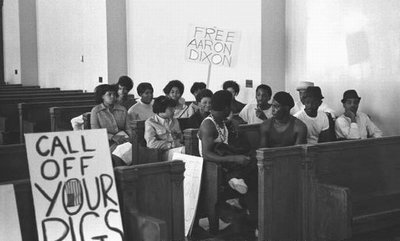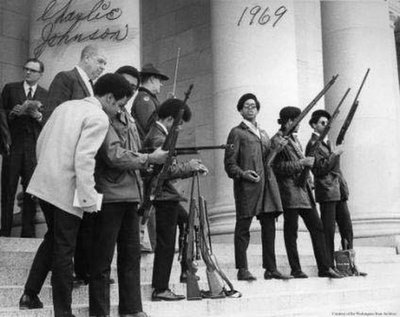May 18, 2006
History of Black Panthers to come alive in classrooms, meeting, Web site
The short, intriguing history of the Black Panthers in Seattle will come to life again when the Black Panther Party History and Memory Project Web site is unveiled Saturday at a public event at the Langston Hughes Performing Arts Center.
The event, from 3 to 5 p.m. at the center, 104 17th Ave. S., will include a question-and-answer session with former Black Panthers Aaron Dixon, Elmer Dixon and Garry Owens.
The Web site, created as part of the UW’s Seattle Civil Rights and Labor History Project, is a resource for learning about the history of civil rights activism in western Washington and a teaching tool for high school students.
The Web site grew out of a reunion staged by the Black Panther Party Legacy Committee. Much of the work, including 13 video-recorded oral histories with former Panthers, was done by Janet Jones, assistant to the vice provost for student relations at the UW and an undergraduate history major.
The Web site has excerpts from the videos and photos, documents, 100 newspaper articles about the Black Panthers, transcripts of a 1970 Congressional investigation into the Panthers and interviews with other relevant historical figures such as former Seattle Mayor Wes Uhlman, who prevented an FBI raid on the Panthers’ Seattle headquarters. Also included on the site are free lesson plans that teachers can use in teaching about Seattle civil rights history.
“Without question this is the most extensive online site of any Black Panther Chapter, including Oakland, where the party was founded,” said James Gregory, a UW history professor and founder of the Seattle Civil Rights and Labor History Project.
The Seattle Black Panther chapter existed from 1968 to 1978 and is an organization that intrigues people, according to Gregory and Jones.
“The contrast of the threat posed by guns they carried and the public service provided by such things as the breakfast programs for children that the Black Panthers sponsored are what makes the group so interesting,” said Gregory. “People want to know about the lives of these men and what led them to join the Black Panthers.”
“They are a part of the Seattle civil rights era that today’s younger generation is attracted to and makes it such an attraction for teaching,” added Jones. “The Seattle chapter was one of the most successful for the Black Panthers because of its links to other community groups and cultures. For example, it was very effective with working with doctors at the UW, and it also founded the Carolyn Downs Family Medical Center on First Hill to serve the black community.”
Jones said the project is still interested in collecting material about the Black Panthers, and is particularly interested in information about women who were active in the organization. People may contact the project via e-mail at civilr@u.washington.edu.
The Seattle Black Panther Party History and Memory Project is located online at http://depts.washington.edu/civilr/BPP.htm. The Seattle Civil Rights and Labor History Project is located online at www.civilrights.washington.edu.




